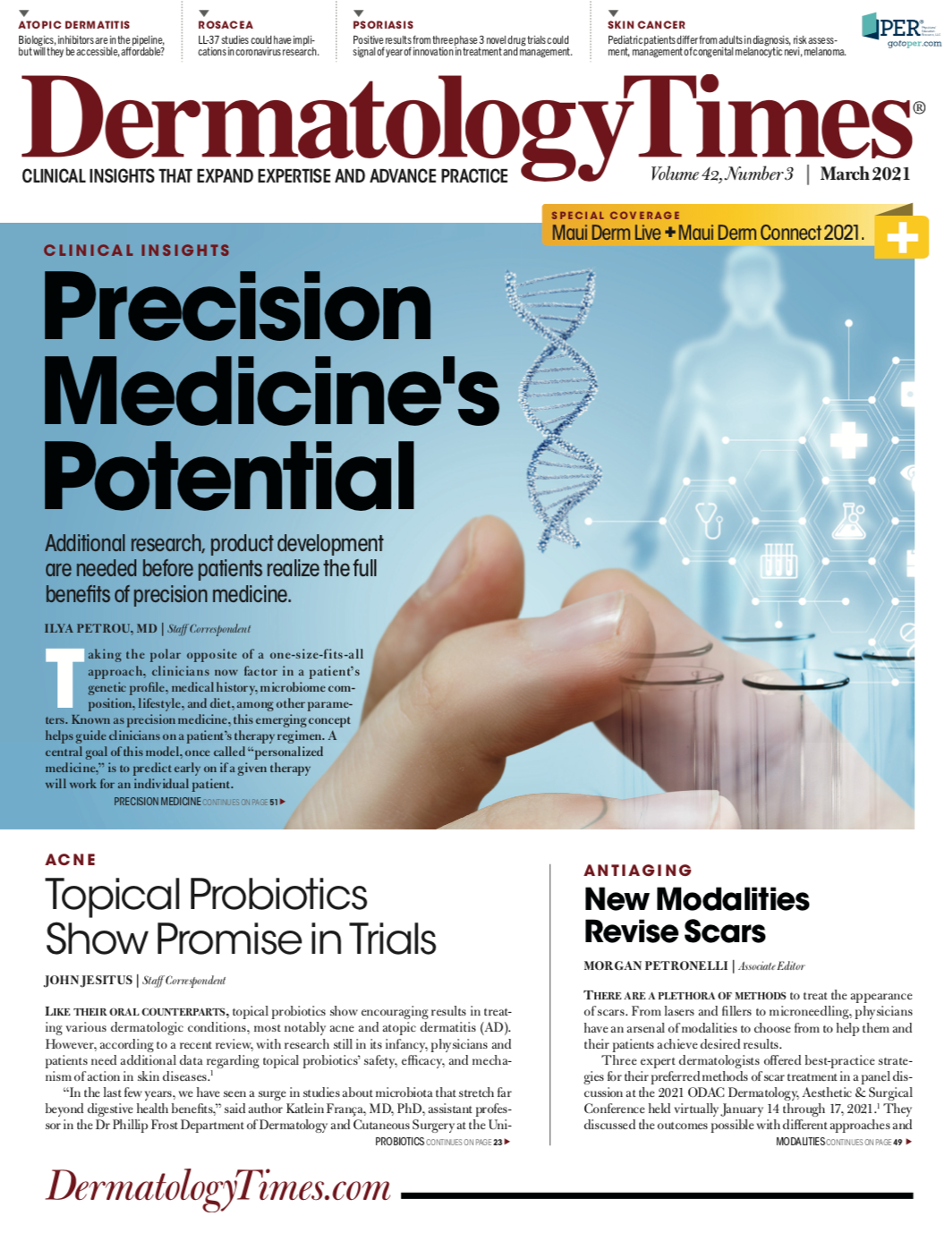- Case-Based Roundtable
- General Dermatology
- Eczema
- Chronic Hand Eczema
- Alopecia
- Aesthetics
- Vitiligo
- COVID-19
- Actinic Keratosis
- Precision Medicine and Biologics
- Rare Disease
- Wound Care
- Rosacea
- Psoriasis
- Psoriatic Arthritis
- Atopic Dermatitis
- Melasma
- NP and PA
- Skin Cancer
- Hidradenitis Suppurativa
- Drug Watch
- Pigmentary Disorders
- Acne
- Pediatric Dermatology
- Practice Management
- Prurigo Nodularis
- Buy-and-Bill
Publication
Article
Dermatology Times
The Potential of Precision Medicine
Author(s):
Taking the polar opposite of a one-size-fits-all approach, clinicians now factor in a patient’s genetic profile, medical history, microbiome composition, lifestyle, and diet, among other parameters, otherwise known as precision medicine.
Taking the polar opposite of a one-size-fits-all approach, clinicians now factor in a patient’s genetic profile, medical history, microbiome composition, lifestyle, and diet, among other parameters. Known as precision medicine, this emerging concept helps guide clinicians on a patient’s therapy regimen. A central goal of this model, once called “personalized medicine,” is to predict early on if a given therapy will work for an individual patient.
Despite the futuristic genetics involved in personalized medicine, the basic tenet is hardly novel. It’s a matter of degree. “Physicians are already practicing precision or personalized medicine every day as they try to determine the best therapy for each patient that results in quick recovery time with little or no adverse events,” said Julie C. Harper, MD, of the Dermatology and Skin Care Center of Birmingham in Alabama. “Although it is early days, we are trying to take this concept a step further by using the patient’s genetic profile, medical history, microbiome, lifestyle, diet and other environmental factors to create the most effective treatment plan for that individual.”
PERSONALIZED BENEFITS
As precision medicine becomes increasingly influential in both dermatology and broader clinical practice, clinicians are looking for ways to implement this approach. “It would save the medical system and patients a lot of money and time if we could predict which biologic works best for each person...however, there still isn’t any way to predict outcomes,” said Zoe Diana Draelos, MD, of Dermatology Consulting Services, PLLC, in High Point, North Carolina and Dermatology Times’® chief medical editor.
IMPROVING PSORIASIS, PSORIATIC ARTHRITIS OUTCOMES
Although there have been exciting developments in personalized medicine in dermatology, including experimental gene expression profiling tests treating and managing melanoma, the general consensus is that there is still a long way to go before patients benefit from the full impact of precision medicine’s capabilities for other skin diseases. Psoriasis and psoriatic arthritis are two areas where personalized medicine could play a major role.
“It is not uncommon that patients go through 1 or 2 different biologic drug therapies, spending three months on each just to find out that they are suboptimal or ineffective while costing tens of thousands of dollars in medical bills,” said Draelos.
Precision medicine could also provide alternatives for patients with contraindications that could limit therapy choice. For example, clinicians can choose from an ever-increasing number of innovative biologics to treat patients with moderate to severe psoriasis. As effective as these agents are in quelling and managing symptoms, they may be contraindicated for patients with arthritis, obesity, personal or family history of heart attack, diabetes, high blood pressure, smoking, cancer history, multiple sclerosis, lupus, Crohn disease or ulcerative colitis, hepatitis B or C, positive test for tuberculosis or HIV, positive pregnancy test or a woman of childbearing potential, among others.1,2
Some medications can prove to be better suited than others for individual patients, depending on their individual patient parameters.
“In psoriasis, there are many specific comorbidities or other conditions and patient parameters affecting patients with psoriasis that determine which drug we are going to use for them. That is the essence of personalized medicine,” said Mark Lebwohl, MD, dean for Clinical Therapeutics, and Chairman Emeritus, Waldman Department of Dermatology, Icahn School of Medicine at Mount Sinai, New York, New York.
He added that insurance companies will often promote certain medications that will generate the most money for them. The companies call it a discount or rebate but, according to Lebwohl, many of those dollars end up in the coffers of insurance companies.
“We know, and we can determine based on other factors in our patients, what the best therapy would be for them, but the insurers get in the way,” said Lebwohl. “They only care about one thing which is how much money they will earn when we prescribe certain drugs. In my view, this remains one of the main challenges going forward in personalized medicine.”
The dilemma in personalized medicine is the abundance of therapeutic options that clinicians and their patients can choose from, he said. That’s already true for psoriasis and acne treatments and will be the case for atopic dermatitis (AD) in a few short years.
BIOMARKERS MAY PLAY KEY ROLE
Whether used for discovery or for prognostic and theranostic approaches, biomarkers have become one of the main focuses of precision medicine. The push to research and find different biomarkers associated with dermatologic diseases such as AD has resulted in the discovery of useful biomarkers that could in the future lead to more targeted therapies specific to the individual genetic makeup and personal parameters of the patient in the future.
“I think the biomarkers, transcription work, and other approaches that are being used have been hypothesis-generating and have uncovered some interesting and important pathways to be probed with follow-up research,” said Jonathan Silverberg, MD, PHD, MPH, associate professor, director of Clinical Research, director of Patch Testing, George Washington University School of Medicine and Health Sciences, Washington, DC. “As such, I believe exploratory biomarkers have their purpose and are here to stay.”
Although research is advancing, there is still much to learn about biomarkers, including decision-based biomarkers and disease biomarkers. According to Silverberg, the discovery of markers that fit the definition of a true biomarker remains a challenge. The goal would be to have a marker that would perform in AD or in other chronic inflammatory skin diseases the way, for example, hemoglobin A1c performs in diabetes as what has become essentially a universal measure of disease control.
“I would argue that we are decades away from such high-level specific biomarkers for atopic dermatitis,” Silverberg said. “Unfortunately, at this point, we won’t have enough to go on to realize a precision medicine approach in our therapeutic decision making. But with ongoing research that could change rapidly.”
APPROACH SHOWS PROMISE FOR ANTI-AGING, COSMECEUTICALS
Personalized medicine in the classical sense is practiced regularly in the cosmeceutical field, Draelos said. One of the biggest breakthroughs center on platelet rich plasma (PRP) techniques being used for truly personalized treatments.
Clinicians harvest the patient’s platelets and process them such that they are rich in growth factors. These can then be reinjected into the patient’s scalp to encourage hair growth or into the face to encourage collagen growth. Topical PRP therapies can be applied in on the skin as a personalized pharmaceutical in a vehicle that contains an individual patient’s own platelet derived growth factors, epidermal growth factors, and fibroblast growth factors.
“This is a little different approach to personalized medicine,” said Draelos. “The doctor is not really making a decision about what drug to give someone based on their disease. Instead, the physician is harvesting the patient’s own unique body-made materials and repositioning them in different areas of the body to deliver results.”
Beyond cosmetic and procedural dermatology, Draelos said that personalized medical techniques such as PRP and cell-derived materials are being used in elite athletes to stimulate bone growth, in dental surgery to stimulate mandible and gingival growth, as well as to expedite healing for diabetic ulcers.
She predicted that, while the progressive understanding of human genes and the quest to identify which genes code for certain diseases including the advent of CRISPR-Cas and its ability to address genetic abnormalities and deliver gene therapy are all in their infancy, and interest in their use will increase.
“I think perhaps there is a little more media hype regarding personalized medicine than reality at this point,” Draelos said. “For the average person, personalized medicine is not a wide- spread reality to deliver therapeutic care. But people are hopeful that personalized medicine will actually come to fruition. I have no doubt that it will.”
Disclosures:
Draelos, Harper, Lebwohl and Silverbergreported no relevant disclosures or financial interests.
References:
1, Nassar SF, Raddassi K, Ubhi B, Doktorski J, Abulaban A. Precision Medicine: Steps along the Road to Combat Human Cancer. Cells. 2020;9(9):2056. Published 2020 Sep 9. doi:10.3390/cells9092056
2. Kaushik SB, Lebwohl MG. Psoriasis: Which therapy for which patient: Psori- asi comorbidities and preferred systemic agents. J Am Acad Dermatol. 2019 Jan;80(1):27-40. doi: 10.1016/j.jaad.2018.06.057.Epub 2018 Jul 11







